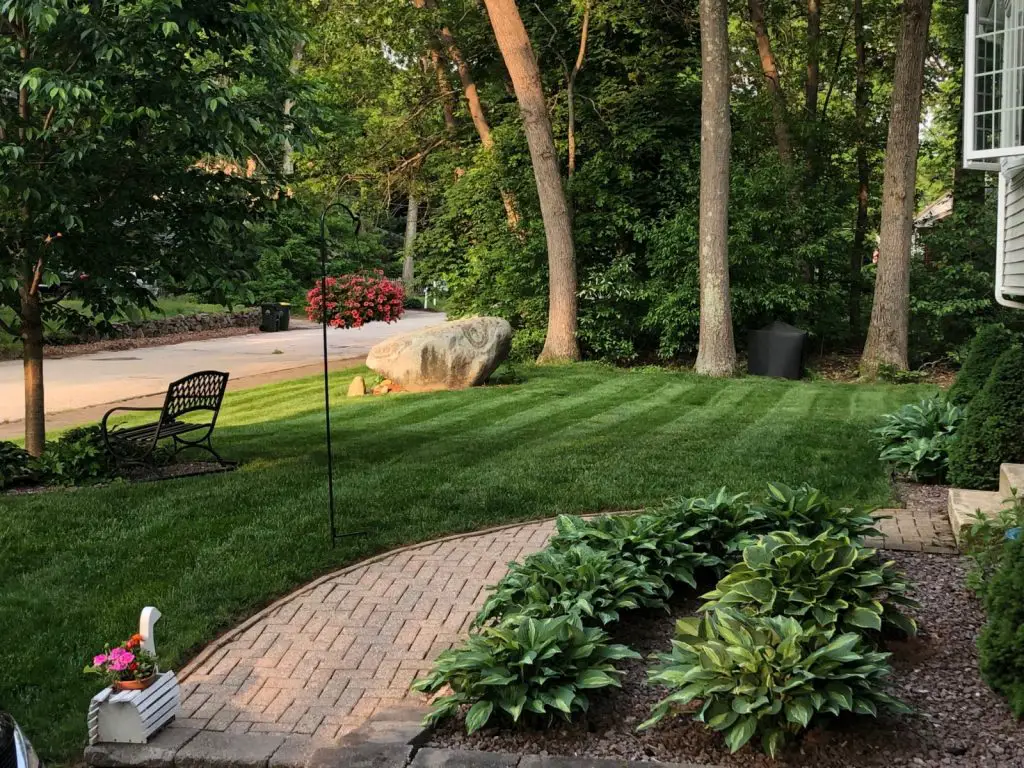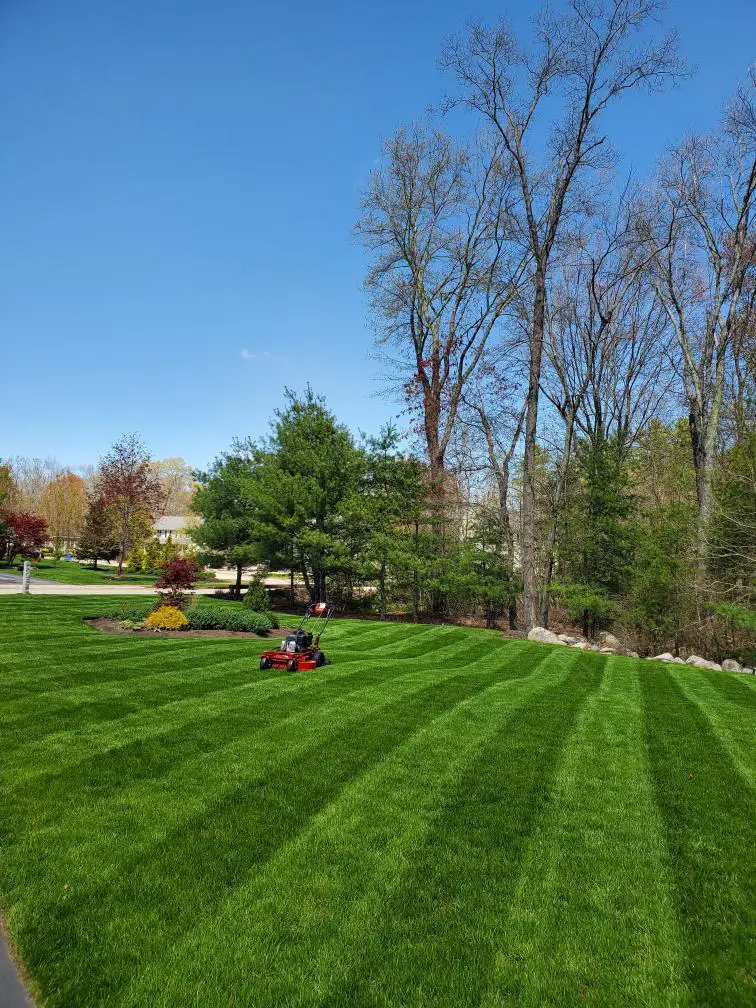Table of Contents
Maintaining an annual lawn care schedule is paramount to keeping your grass healthy. With New England’s distinctive seasons, it may be challenging to know precisely when to fertilize your lawn or apply weed control measures, especially as there are often seasonal variations in weather and climate to account for.
Lawn Phix has created this detailed lawn care schedule to help you care for your cool-season grasses. If your property is located in the Northeast, Zone 6b), you can use our New England month-by-month lawn care calendar and schedule to chart your lawn care tasks at a glance. Check out the guide for each month’s turf nutrition and lawn care tasks to promote and maintain healthy, lush green turf.
View and make a copy of our lawn care calendar on Google Sheets. You can also download a free copy of our cool-season lawn care guide here.
March Lawn Care
New England Marches can be bitter cold. Even though spring arrives on March 20, the weather may not always cooperate with your lawn care plans. During this month, however, you’re likely to be able to complete these tasks, which will help you prepare for the months ahead.
- Clean up your lawn by removing branches, sticks, acorns, pinecones, and leaves.
- Evaluate your lawn by looking for signs of snow mold
- Prepare your lawn mower for the season ahead by sharpening its blades. We love the Gator G3 mulching blade by Oregon.
- Conduct a soil test so you can find out what nutrients your soil may be lacking. You’ll want to amend the soil to support the health of grass roots.

April Lawn Care
In April, you can focus on early spring lawn care tasks like raking to rejuvenate cool-season grasses. Aim to complete these chores this month:
- Lightly rake your lawn to promote healthy airflow. Raking also helps grass blades stand up, allowing them to absorb more sunlight.
- Apply pre-emergent herbicides before soil temperatures exceed 55 degrees Fahrenheit. Tip: when the forsythia begin to bloom, crabgrass seeds are germinating. You’ll want to act to prevent these weeds from sprouting.
- Apply spring fertilizer application if you didn’t apply late fall season fertilizer.
- Apply humic acids and micronutrients to your soil to promote healthful soil microbes. (Kelp4Less ExtremeBlend or Green lawn & Turf or lime here if needed).
Other products to keep in mind for promoting your healthy lawn in April include:
- Products:
- Barricade (liquid)
- 0-0-7 Prodiamine (granular)
- 25-0-10 with Dimension (granular)
- Dimension 2EW (liquid)
- Kelp4Less Extreme Blend
- Green lawn & Turf
May Lawn Care
Once May arrives, you’ll want to ramp up your lawn care routine.
- Mow your grass tall and often. Mulch your clippings back into the grass. Don’t bag grass clippings unless they are too long, in which case you need to mow taller and/or more frequently. Aim for 3 inch grass blades.
- Continue to amend soil based on your spring soil test results. Add a starter fertilizer once soil temps hit 60 degrees and your lawn begins to grow in ernest.
- Use Grub Control & Treatment: If there’s a history of grubs or sod webworms, add grub prevention – we highly recommend Acelepryn. To kill lawn grubs within 48 hours, use an insecticide such as Dylox.
- Spot spray and kill weeds. For a detailed post about weed control, read How To Get Rid of and Control Weeds in Your Lawn.
- Understand N counts by using our Nitrogen Calculator.
- Begin your fungicide-preventative treatments now.
- Products:
- Acelepryn liquid or granular
- Kelp4Less
- Carbon Phix
- Fungicide prevention
June Lawn Care
- Apply a second application of pre-emergent, but use Dithiopyr. It offers post-emergent qualities that will help kill crabgrass and dandelions weeds, and not interfere with fall overseeding.
- Begin your irrigation schedule. Aim for 1 to 1.5 inches of water per week, including natural rainwater. Water deeply but infrequently: 2-3 times per week at the most, preferably between 4-9 a.m.
- Lawn fungus, such as brown patch, is a concern at this point in the year. Seasons with lots of rain and hot humid overnight temps create an ideal environment for brown patch and similar weeds. An application of Heritage G can prevent and control turfgrass diseases for up to 28 days (also see products from May above)
- Raise mower height to 3.5 inches (depending on grass type)
- Spot-spray broadleaf weeds in earlier mornings or later evenings when air temperatures are under 85 degrees

July Lawn Care
During the heat of the summer season, remember that low rainfalls and high heat can cause dormant grasses. You’ll need to water your lawn as directed to keep it green and healthy.
- Irrigate as long as your town allows. Aiming for 1.5 inches of weekly watering
- Watch for lawn diseases and fungus, especially as humidity rises
- Apply curative rates of fungicides
- Watch for lawn grubs and other lawn insects, The sooner you combat them, the more likely you’ll be able to prevent a serious infestation.
- Fertilize with slow release nitrogen fertilizer and organic lawn products
- Summer Survival (Potash , Humic Acid, Sea Kelp) is a great option
- Never fertilize dormant turf
August Lawn Care
The dog days of summer heat call for vigilance–you’ll want to be weary of insect pests and lawn diseases.
- Keep an eye out for lawn diseases and fungus – especially as humidity rises.
- Treat with liquid lawn fungicides
- Watch for grubs and other lawn insects
- Use Dylox Granular or Dylox Liquid to kill grubs and cinch bugs
- Fertilize with organic, slow-release fertilizer
- Tip: Do not fertilize dormant turf
- Apply micos such as 0-0-2 MicroGreene, RGS or Humic12
- Prepare to overseed and kill lawn weeds
- Depending on weed type, use broadleaf weed killers and/or crabgrass killers
- Now is the best time to renovate your lawn.

September Lawn Care
As the fall season approaches, you’ll need to start shifting cool-season grass care to accommodate changes in the weather. This is my favorite time of year and the best time to feed your lawn.
- This month tends to be the ideal time of year to start a new lawn and/or overseed you lawn.
- Dethatch grass using a power rake, tow-behind dethatcher, or dethatching rake.
- Core aeratation doing a double-pass to reduce soil compaction; work up/down then left/right (north/south and east/west)
- Mow low around 2 – 2.5 inches.
- Overseed or slice seed with a quality grass seed such as Jonathan Green Black Beauty or GCI Turf. Depending on how thin or think your turn is, aim for 3- lbs. per 1,000
- Fertilize with a quality starter fertilizer such as XSTART from Yard Mastery.
- Lime: depending on soil needs, a calcitic lime like Jonathan Green Magical
- When seeding, you can also use Tenacity.
- If you’re not seeding, consider applyi
October Lawn Care
October typically calls for attention to leaf removal and other fall-related tasks.
- Mow low again, aiming for a 2.3 to 3 inch grass height. The final cut of the fall season should be 2 inches.
- If you skipped September tasks, do it early as nighttime temps will drop to unfavorable temperatures for new seedlings that are trying to germinate.
- Begin winterizer fertilizer like Macro-Micro Blend by Yard Mastery or ProPEAT 17-0-4
- Depending on location – After your final mow (when the grass stops top growth) and before your ground freezes
Related post: Prepare your lawn for winter

November Lawn Care
Now is the time to wrap up your annual lawn care routine.
- Lime with pelletized lime to over-winter: Jonathan Green Magical
- Final application of lawn fertilizers: Macro-Micro Blend by Yard Mastery or ProPEAT 17-0-4
- Final mow with a HOC of ~2″
Use this cool season lawn care guide to maintain your attractive lawn. Please let me know what you think of the plan by leaving a comment below.
FAQs
When is the best time to overseed my lawn?
For cool-season lawns, the best time to overseed grass is late summer / early fall. For example, in the Northeast and Zone 5-6, the last week of August or the beginning of September tend to provide the best times for new grass growth. The number of invasive weeds is much lower in September than during spring seeding in the spring (April).
Can I fertilize my lawn in the summertime?
If you can irrigate regularly, you can still add fertilizer to your lawn. However, applying less nitrogen during the hot summer months is best, especially when drought stress occurs. Ideally, spoon-feeding your lawn with micronutrients such as humic acid and sea kelp (Kelp4Less ExtremeBlend) or a combination of both with molasses powder (Kelp4Less Green Lawn & Turf). Molasses in the hotter months can provide energy in the form of sugars/carbohydrates, which can also help “dethatch” the lawn.
How early can I fertilize my lawn in spring?
In the Northeast and Massachusetts (Zone 5-6), for example, you can begin to feed your lawn in April and May. Fertilizing your lawn too early can cause excessive top growth which isn’t ideal if there’s still a risk of freezing overnight temperatures and morning frost. When the air and soil temperatures are consistently in the 40s and 50s respectively, you can begin your lawn fertilizer schedule.
How frequently should I mow my lawn?
During the peak growing season (May & June in the Northeast), you can mow as frequently as 2-3 times per week. This, of course, also depends on your fertilization and watering schedule. Ideally, it’s best to follow the “1/3 rule” where you never remove more than 1/3 of the grass blade during each mowing. I tell all of my clients to aim for at least once per week.
When should I stop mowing my lawn in Massachusetts?
When the grass stops growing, you should cease mowing. This usually occurs around Thanksgiving.
When should I start cutting grass in Massachusetts?
In the early spring–usually the first 1-2 weeks of April
When should you not fertilize your lawn?
When the lawn is under stress, especially during times of drought and heat stress (summer months).
Do you apply fertilizer to wet or dry grass?
Dry grass is best unless it is a weed and feed product that needs to be wet to stick to the grass


Hi,
I appreciate you providing this info! I’m new at caring for my lawn, but have really enjoyed learning over the last few years.
Recently I’ve discovered Poa Annua in a large portion of my yard. We live in Boston. I know I need to apply a pre-emergent in the fall for prevention, but since I’m seeing the weeds in my yard now, I’ve read that putting down a post-emergent would be a good idea. The problem is that most post-emergent herbicides are for warm season grasses. What would you recommend for this problem?
Thanks for your help!
Hi Abby. You can use Tenacity to damage the plant. But they are annuals, so they will soon die off by the summer. The Tenacity will cause it to turn brown – not sure if you want that at this time of year.
https://lawnphix.com/lawn-care/poa-annua-annual-bluegrass-weed-control/
Apply your normal split applications of pre-emergents in early April and early June, and again late August. Mow tall and avoid over-watering. These will help suppress poa annua. But keep in mind that they drop many seeds. These seeds are tough and can remain dormant in the soil for several years before germinating. So it’s a classic case of being a marathon and not a sprint. Good luck!
Hi,
I really enjoy your month by month care program. One of a kind out there.
I live in Lexington MA, and I’ve been having a lot of moss growing all over. And so are my neighbors. I know about poor drainage, acidic soil and wet/humid conditions, but is moss a growing problem now a days? (pardon the pun). Anyway, what can I do to mitigate this issue? thanks for you time and efforts.
Al
Hi Al – thanks! Sounds like you know what type of soil conditions are for moss. But it can really grow anywhere. Aside from what you mentioned (damp conditions, shady area etc.) moss also grows because of bare spots. Mother Nature doesn’t like bare spots and will fill it in, be it moss or weeds etc. You could kill the moss with Moss Out when try to re-seed that area. I’d probably suggest bringing in some new screened loam and overseeding heavily to cover those areas. Good luck and I hope this helps!
Hi Mark,
Great information for someone who’s completely new to lawn care!
I had some large patches of dead grass (learned recently due to grubs – I thought it was just dormant, and it wasn’t coming back). I just removed the dead grass, but is it too late to seed? If it is, and I seed in the fall, would I apply the starter fertilizer to the bare spots, seed, and then switch back to regular for the rest of the lawn?
Hi Julio,
Thanks! Depending on where you live, it may not be too late. I’m in Massachusetts and just seeded my backyard. Just get good seed-to-soil contact, cover with peat moss, and keep it damp. If you seeded in the fall, I would overseed the entire yard, hit those bare spots heavier, and use starter fertilizer over the entire lawn.
Good luck!
Great article! I’ve been following along to your google sheet which is a great toolfor a rookie like me. So far I’ve done the prodiamine and propeat 13-5-8. I’m due for another pro peat (17-0-4) fertilizer soon and then after that also going to apply the Andersons fertilizer with .25% dimension 21-0-10 as the second pre-emergent (following your 5 best pre-emergents article) instead of the 19-0-7. My Question is around the weeds and clovers I already have in my lawn, since there’s a decent amount in some spots. Should I replace the next fertilizer with a weed and feed product to help kill the current weeds, clovers, etc, or should I just continue the course with the next propeat 17-0-4 and Andersons 21-0-10? Or maybe just spot spray the weeds? Pretty big yard so hand picking the weeds would be quite the task. I’m in Foxboro, MA. Thanks again for posting all this great stuff!
Hi Tim. Thanks for following along and for your comment! I’d personally spot spray. You will have better results. Weed and feed can be tricky: the ground needs to be damp for the product to stick to the weeds. You also have to be mindful of your mowing and irrigation/weather.
Feel free to also use the new Carbon Phix as a replacement. It’s a 20-0-12 and has lots of great stuff like iron and Humic.
Is it too late to put down Winterguard Weed and Feed in New Jersey?
Hi Trish – If your soil temps are still in the 50s, then the herbicides should still be effective. If not, I’d apply a winter fertilizer (no herbicides) when the grass’ top-growth has stopped – after your final mowing. I like the 10-0-20 by Jonathan Green.
Hey Mark,
Just wanted to say this is all great info to help someone get started on their lawn care journey! As someone who is interested myself, I really enjoyed your in depth descriptions for each month! I find lawn care to vary so much during different seasons and these instructions were great for every time in the year! Thanks so much for sharing!!
Hi, Just discovered your site. Great info. We live south of Boston. I did Scott’s Turf Builder Halts in April, Turf Builder Weed and Feed in June. I was due to apply Summerguard end of July/early August but we have had a drought and had the terrible heat wave so I never applied. It is now August 18. Is it too late to apply Summerguard? We do have a well and irrigation. I was just going to skip Summerguard and do the suggested next step Thick’R Lawn the first week in September.
You can apply that now. Summerguard contains Bifen which will help with the surface insects, too.
I have a question for you can you help me out? I’m in NJ with a lawn problem
Hi Eileen – happy to help. Leave your question here in the comments or message here.